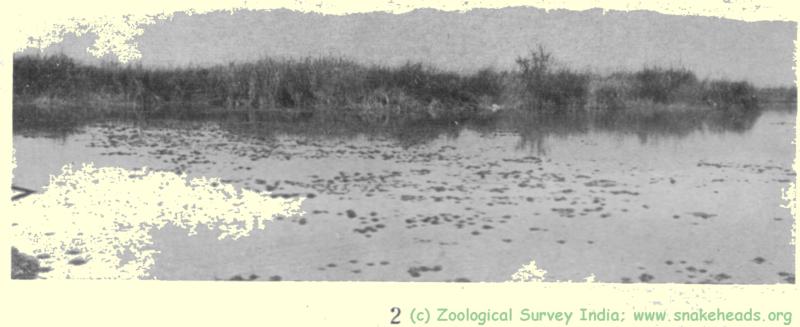
The fish of the Shan Plateau and its inimediate vielnity have as yet received little attention from ichthyologists. In 1893 Boulenger ( Ann. Mag. Nat. Hist. (6) xii, pp. 198-203 ) described a collection of twenty-seven species made by the late Mr. E. W. Oates in the Southern Shan States, while Vinciguerra reported upon the late Signor Fea's collection in 1889 in the Ann. Mus. Stor. Nat. Genova (2) i (xxix), pp. 129-260. The latter collection, thongh none of it came actually from the plateau, included numerous specimens from Karen-ni, which lies immediately to the south, and from the Upper Salween.
A large part of Mr. Oates's collection was obtained at Fort Stedman on the Inlé Lake, but the fish were probably purchased in the market, several of the species are not lacustrine and tbe most interesting of the true Inlé forms, most of which are of very small size, were not represented.
 | Plate XXVI, Fig. 2: View in the Intermediate Zone, showing floating islands in their natural condition in the background and sub-aquatic thickets of Ceratophyllum rising to the surface in the foreground. |
The fauna of the Inlé Lake is of a highly peculiar character and it is not surprising, that among the smaller fish we obtained there is a large proportion of undescribed forms. It was, however, perhaps hardly to be expected that we should discover no less than three new genera and even a new family. These belong either to the Cyprinidae or to the eels : it is among the latter that the new family finds a place. Its type is, indeed, perhaps the most primitive form of eel yet known. New species were discovered also in the genera Nemachilus and Barilius (Cyprinidae) and Ophiocephalus (Ophiocephalidae).
The complete list of the specles now known to inhabit the lake, all of which are represented in our collection, is as follows. For convenience of reference I have arranged them here according to the order adopted in Day's volumes in the Fauna of British India , but I have departed somewhat from this system in the taxonomic part of the paper.
[ ... ]
[ ... ]
Family Ophiocephalidae
[ ... ]
In addition to these twenty-two species and races the following fish are known to inhabit the Inlé basin, having been recorded From Ford Stedman by Boulenger ( op. cit.: 1893 ) or being represented in our collection: -
[ ... ]
Thirty-one species of fish, belonging to 7 families and 17 genera are known to live in the Inlé basin. Six of these familles are widely distributed in the fresh waters of the Oriental and Ethioplan Regions, but one (Chaudhuridae), which is desceribed for the first time in this paper, is only known from the Inlé Lake, in which it is represented by a small and remarkably primitive species.
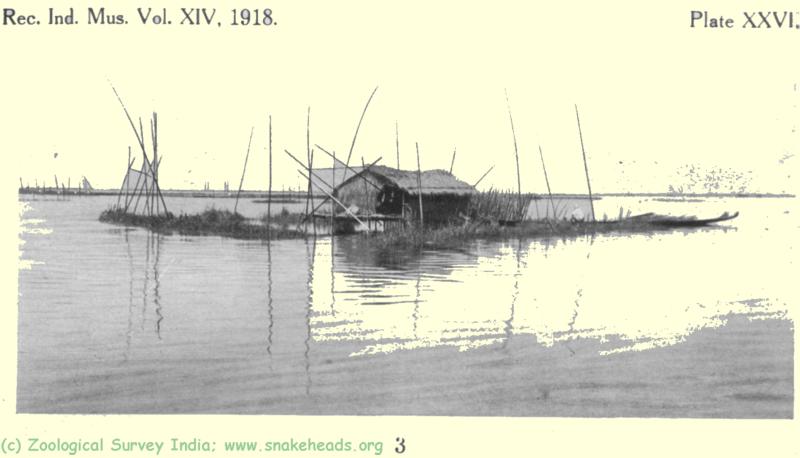 | Plate XXVI. Fig. 3: A fishing hut built on piles in the Central Region and surrounded by a floating breakwater anchored by means of poles stuck through it into the bottom of the lake. |
Of the 17 genera, 13 are distributed all over the Indian and the Indo-Chinese sections of the Oriental Region, while one ( Monopterus ) first makes its appearance, as we go from west to east, in Burma, but ranges as a monotypic genus over the whole of the eastern part of the Oriental and the south-eastern districts of the Palaearetic Regions. It may therefore be classed as Far Eastern. Another genus ( Microrasbora ), though here described as new, is possibly also Far Eastern, for the small size of its representatives may well have caused them to be overlooked in many places and species probably occur in the Malay Peninsula. The remaining two genera, of the 17 are only known at present from the Inlé basin; one( Chaudhuria ) is the genotype of the new family to which I have already alluded, while the other ( Sawbwa ) is represented by a peculiar little scaleless fish somewhat remote from any species known elsewhere. It belongs to the family Cyprinidae.
Of the 30 species of fish, no less than 12 (i.e., 2/5ths or -10 percent.) are known only from the Inlé lake and He-Ho basins, while a sub-species ( Cyprinus carpio intha ) apparently occurs only in the Southern Shan States. Boulenger has noticed (by implication) the Siamese element in the fish-fauna, but this element is much less strongly marked than the endemic one, being represented by but two species. They are Ophiocephalus siamensis and Barilius ornatus .Neither of these is a true lacustrine fish ; both were discovered in the Menam and Barilius ornatus has also been found in the Upper Salween. Small as the Siamese element is, however, it is but little larger than what we may call the endemic Burniese element, which is also represented by two species ( Barbus stoliczkanus and Lepidocephalus berdmorei ), but in addition by a sub-species of the Indian Barbus sarana . The one Far Eastern species is Monopterus albus .
The fishermen of the Inlé Lake belong to a tribe alien to the Shans and speaking a dialect of Burmese thought to be akin to that spoken in Tavoy. They call themselves Intha or Sons of the Lake. ln a pamphlet on the Inlé fisheries published recently by the Government of Burma I have given a list of the local names of fish, but at the time of its publication was unable to identify many of the species specifically owing to the fact that the collection had not been completely worked out. The indigenous names were repeatedly checked both among the fishermen and in the bazaar at Fort Stedman. Mr. C. E. Browne, I.S.O., Political Adviser at yawnghwe has been kind enough to revise their orthography. Nga is the ordinary, Burmese for «fish», but it is never omitted in referring to any particular species.
| [ ... ] | |
| Nga ohn-ma | Ophiocephalus harcourt-butleri |
| [ ... ] |
Most of these names are dialect or local, but Day in the Fauna of British India gives «Nga yan» as one of the Burmese names of Ophiocephalus striatus . [ ...]
This fish is by far the largest in the lake attaining a weight of 10 lbs. or over. Together with Clarias batrarchus it has a pre-eminence in favour among the Europeans of the district, but I am not sure that the Intha themselves do not prefer the true Carp. O. striatus is caught with hook and line (the bait often being a small live Notopterus ) and in special traps made of reeds. It is often abundant in the local markets.
The species has a wide distribution in the Continental Asia extending as far as Eastern China and the Philippines.
 | Fig. 2. Ophiocephalus harcourt-butleri, sp. nov. |
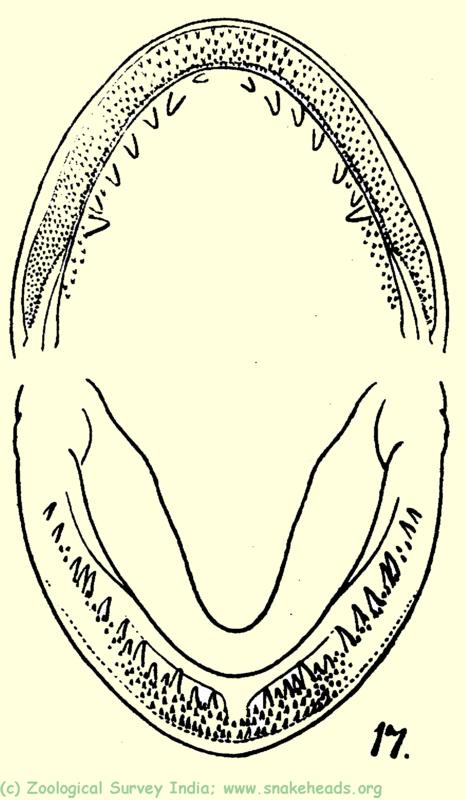 | Plate IV. Fig. 17. Jaws and teeth of Ophiocephalus harcourt-butleri, sp. nov. |
The teeth are for the most part villiform and are arranged in numerous lines on both jaws, but there is an inner row of larger conical teeth both in the upper and in the lower jaw. The arrangement is best shown in a figure ( pl. IV, fig. 17 ).
Two color forms can be distinguished:
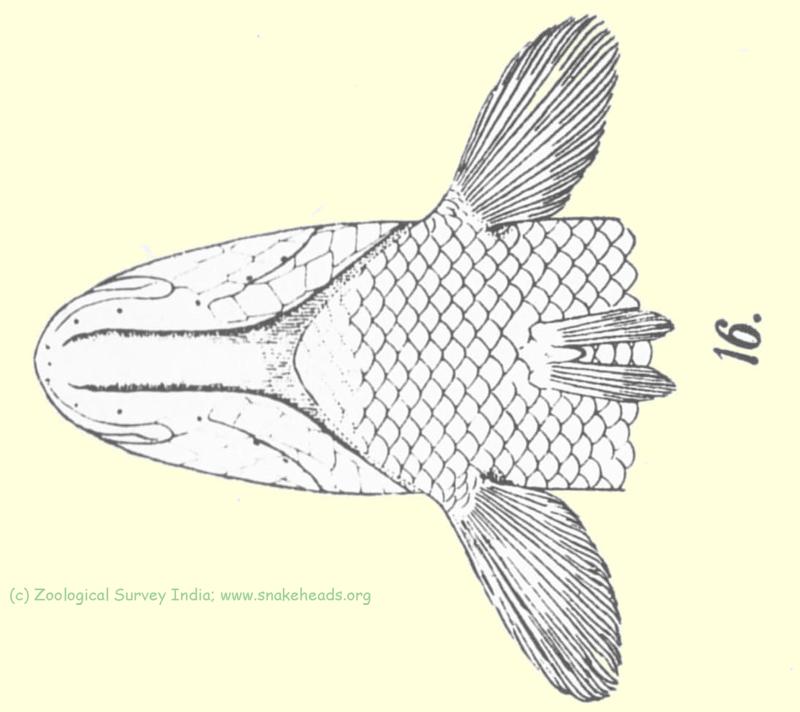 | Plate IV. Fig. 16. Head and forequarters from below of Ophiocephalus harcourt-butleri, sp. nov. |
Our largest specimen (frorn the Inlé Lake) is 22.6 cm long, and from all accounts the species does not grow more than 25 cm long.
Type-specimen . - (Form A) (from the Inlé Lake) No. 9139/1 Zoological Survey of India ( Ind. Mus. ) from Fort Stedman.
Distribution . - This species is abundant all over Yawnghwe and the neighbouring states. We obtained specimens not only from the Inlé Lake but also from He-Ho (3,800 ft.) and Thamakam (4,200 ft.); it lives on a muddy bottom in sluggish streams and also in all parts of the Inlé Lake, hiding itself as a rule among weeds. Large numbers are sold in the local markets.
 | Plate II, fig. 7: A young specimen of Ophiocephalus harcourt-butleri, sp. nov.. |
The species is named after His Honor Sir Harcourt Butler, K.C.S.I., C.I.E., I.C.S., Lieutenant-Govenor of Burma at the time of our visit to Yawnghwe, now Lieutenant-Govenor of the United Provinces.
[ ... ]
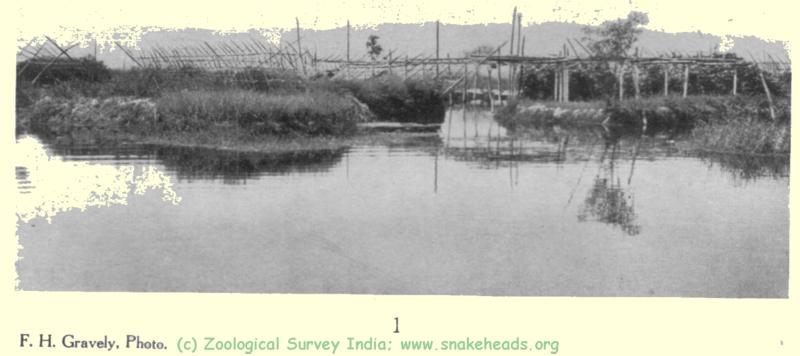 | Plate XXVI. Fig. 1: Floating gardens in the Marginal Zone, showing crops of spring onions, tomatoes and cucumbers, the last on the trellises. |
[ ...]
A coarser type of trap ( pl. VII, fig. 4 ), used chiefly for catching Ophiocephalus striatus , is often set in the lake. It is made of sIender but very strong reed-stems peeled and coated with thitsi varnish. They are fastened parallel to one another by means of bands of some tough bark, twisted round and between them in a double spiral. At the two ends and in the middle there is a twig or strip of bamboo bent in a cirele and fixed inside the reeds to strengthen the whole. The strips of bark and the internal supports are manipulated in such a way that the trap is somewhat compressed at one end ; otherwise it has an almost cylindrical shape. It is about 82 cm. long, and 44 cm. deep. There are two compartments and both the round end of the trap and the partitIon between the compartments are provided with a passage-way of converging reeds. The compressed end is provided with a moveable door of reed-stems. This trap, which is called pwanhnwet-nga-yan is very Iike one from Bengal figured by Day in his hand-book of «Indian Fish and Fishing» compiled for the Fisheries Exhibition in London of 1883. The reference is to pl. 1, fig. 4 of the book. The chief difference is that the Intha trap is truncated at the compressed end instead of being produced
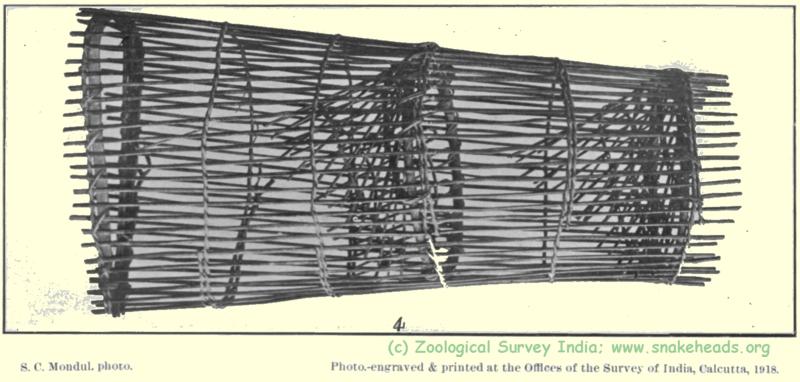 |
[ ... ]
At least six different types of nets are recognised by the revenue officers of the Yawnghwe State. Some of these nets are distinguished by the name of the fish which they are used in catching. There is the nga-yan-paik (i.e., the net for catching Ophiocephalus striatus ), the nga-pein-paik (i.e., the Carp net), and the nga-kon-ma-paik (i.e., the net for catching Barbus sarana ). There are also the hmaw-chit-paik , the paik-yat-kyi -names I cannot explain - and the kun or cast-net.
The price for the monthly licenses for these different nets are as follows: -
| Kind of net | Monthly license |
| Nga-yan-paik | 0.80 Annas |
| Nga-kon-ma-paik | 0.80 Annas |
| Hmaw-chit-paik | 1.80 Annas |
| Paik-yat-kyi | 4.80 Annas |
| Kun | 2.00 Annas |
The relative efficacy of the different nets can be gauged to some extent by the licence paid for their use. I am not sure that all of them are used actually in the lake, for the revenue statistics from which my information is drawn apply to the whole of the State of Yawnghwe and the names given me by the fishermen do not agree with those in the official list.
The Carp net, and the barbel net, are drift-nets of very ordinary structure. That used for the Carp is made of fine silk (imported over-land from China) of considerable length but only about 1 1/2 feet deep; the mesh is 24 mm. across. There are small floats of some very light wood fastened to a double string that runs along the top. They are flattened cylinders about 8 mm. long, and are fastened at intervals of about 15 cm. Along the bottom of the net there are small leaden weights consisting of thin plates about 7 cm. long bent round another double string and hammered tight. When not in use the net is festooned on a bamboo. The net, for barbel is precisely similar in construction, but is made, of cotton and has a slightly smaller mesh, about 20 mm. across. I am told that Ophiocephalus net has a considerably larger mesh. All these are used most commonly in connection with floating islands, which are towed out into the mlddle of the lake and there anchored. The fish take shelter under them, and the nets are drawn round them, or along one side.
The weed-trawl ( pl. V, fig. 2 ) is a much more characteristic net. It has a triangular or almost, triangular frame of variable size, but at least 5 feet Iong. The frame is made of two bamboos bent into an arch above and tied together with twine. A third bamboo passes, transverselv through holes in their free ends. The net itself is bagshaped, and has a small mesh of about 12 mm. lt is made of cotton. A long rope is fastened to each of the lower angles of the framework. Two boats have to be used in fishing with this net. A man stands upright in one of these boats holdino, the top of the framework in his hands, he plunges lt downwards and throws the two ropes across to two men in the other boat. They haul in the ropes until the net is horizontal and the two boats are close together. The bag is then emptied out into the second boat. The contents consist of a mass of weeds, with Carp, Notopterus , Barbus sarana , Ophicephalus striatus and any other fish that may have taken shelter among the weeds.
[ ... ]
[ ... ]
The revenue department of Yawnghwe recognize several different kinds of methods of using fish-hooks, but I have little information as to the methods except that both fishing-rods made of long reeds and long lines with many hooks are used. A common bait for large fish such as Ophicephalus striatus is a small living Notopterus . The cost of the monthly licence for the use of different kinds of fishing lines varies from one to four annas.
[ ... ]
ln the systematic part of this paper I have stated briefly, in discussing each species, its economic status. lt may be convenient here to sumarize what has been said on the subjcet: at the same time I wish to say a little more about the dried whitebait that is so characteristic a product of the Yawnghwe State. All the species comonly sold in the market are abundant, a fact probably correlated with the comparatively small number of species represented in the lake. There are no really large fish in the lnlé Lake and several of the species certainly do not attain the size they attain in the lowland waters of Burma. This may be due to the lack of a sufficoently abundant supply of nitrogenous food or to other causes of like nature. Some of the fish of the lake are always very small, not growing more than an inch long. The great majority of the fish are eaten commonly by the people, but several species are of little economic importance because they are of relatively small size and are at the same time difficult to catch. To this category belong the species of Barilius , a sprat-like fish which as a rule swims near the surface, and Discognathus , which is provided with an adhesive apparatus connected with the mouth and feeds by crawling up houseposts and the like and grazing on the minute vegetation attached thereto.
The chief food fishes among the larger species that are eaten fresh are the following:-
The larger fish are seldom preserved by salting or drying, but halfgrown Murrel are occasionally split, cleadned and salted, while a surplus catch of Cirrhina latia is frequently dried without even being cleaned. Small dried fish of the latter species are sold separatelx from larger ones.
[ ... ]
ToDo: Vinciguerra Articel erarbeiten, Siamensis synonym reference in Fussnote, Britz-Artikel anpassen, Identification list anpassen
1 C. siamensis is a synonym for Channa lucia (Cuvier & Valenciennes, 1831) . This is due to Prachya Musikasinthorn. Back
These passages were originally published under the above title in: Records of the Indian Museum . Vol. 14, no. 1, pp.33-?, 1918. The copyright owner Zoological Survey of India has granted snakeheads.org the right to publish it on the org's site. The copyright of the text is still with the copyright in full amount.
| © 2001 - 2004 snakeheads.org | HOME of this page |